.
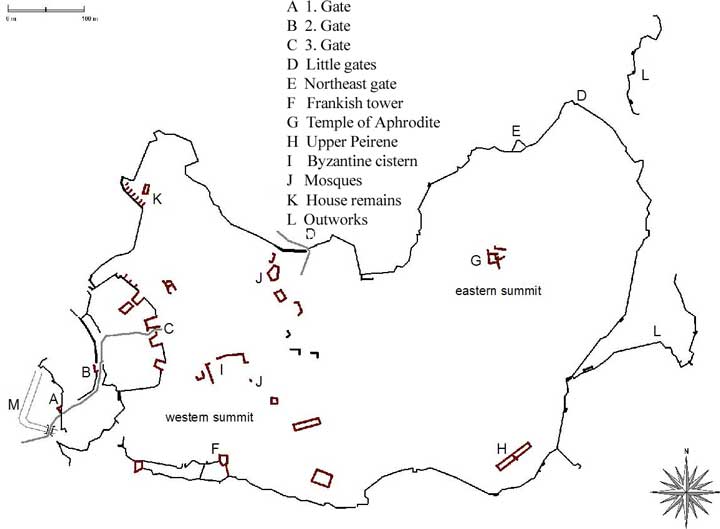
Map of the remains of Acrocorinth
Acrocorinth or Akrokorinth (Gr. Ακροκόρινθος) is a monolithic rock overseeing the ancient city of Corinth, Greece. It used to be the city's ancient and later, medieval acropolis.
An easily defendable position due to its geomorphology was further heavily fortified during the Byzantine Empire as it became the seat of the strategos of the Thema of Hellas.

Pegasus, Acrocorinth
History
The Acrocorinth was continuously occupied from archaic times to the early 19th century. Along with Demetrias and Chalcis, the Acrocorinth during the Hellenistic period formed one of the so-called “Fetters of Greece” – three fortresses garrisoned by the Macedonians to secure their control of the Greek city-states.
The city's archaic acropolis was already an easily defensible position due to its geomorphology; it was further heavily fortified during the Byzantine Empire as it became the seat of the strategos of the Thema of Hellas and later of the Peloponnese. It was defended against the Crusaders for three years by Leo Sgouros. Afterwards it became a fortress of the Frankish Principality of Achaea, the Venetians, and the Ottoman Turks.
Three circuit walls formed the man-made defense of the hill. The highest peak on the site was home to a temple to Aphrodite. The temple was converted to a church, which in turn was converted to a mosque.
The American School's Corinth Excavations began excavations on the Acrocorinth in 1929. Currently, it is one of the most important medieval castle sites of Greece.
Myths and legends
In a Corinthian myth related in the 2nd century CE to Pausanias, Briareus, one of the Hecatonchires, was the arbitrator in a dispute between Poseidon and Helios, between the sea and the sun: His verdict was that the Isthmus of Corinth belonged to Poseidon and the acropolis of Corinth (Acrocorinth) to Helios.[2]
The Upper Pirene spring is located within the encircling walls. "The spring, which is behind the temple, they say was the gift of Asopus to Sisyphus. The latter knew, so runs the legend, that Zeus had ravished Aegina, the daughter of Asopus, but refused to give information to the seeker before he had a spring given him on the Acrocorinthus."[3]
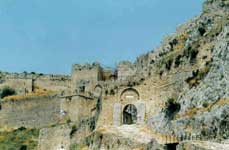
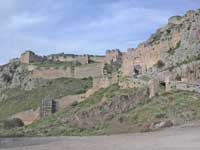
The Frankish Castle of Acrocorinth, view from the Aphrodite Temple
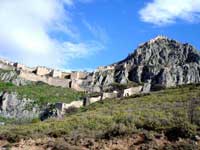
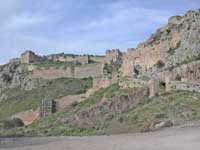
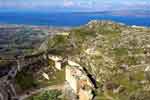
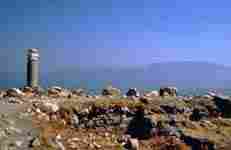

Nowadays it is one of the most important medieval castle sites of Greece.
References
Forrest, George (1988). Boardman, John; Griffin, Jasper; Murray, Oswyn (eds.). Greece and the Hellenistic World. Oxford History of the Classical World. I. Oxford University Press. p. 31.
Pausanias. Description of Greece. 2.1.6, 2.4.7.
Pausanias. Description of Greece. 2.5.1.
Greece :
A - B - C - D - E - F - G - H - I - J - K - L - M -
N - O - P - Q - R - S - T - U - V - W - X - Y - Z
| Ancient Greece
Science, Technology , Medicine , Warfare, , Biographies , Life , Cities/Places/Maps , Arts , Literature , Philosophy ,Olympics, Mythology , History , Images Medieval Greece / Byzantine Empire Science, Technology, Arts, , Warfare , Literature, Biographies, Icons, History Modern Greece Cities, Islands, Regions, Fauna/Flora ,Biographies , History , Warfare, Science/Technology, Literature, Music , Arts , Film/Actors , Sport , Fashion --- |
Retrieved from "http://en.wikipedia.org/"
All text is available under the terms of the GNU Free Documentation License


